5 Things to Never Do on Ab Day
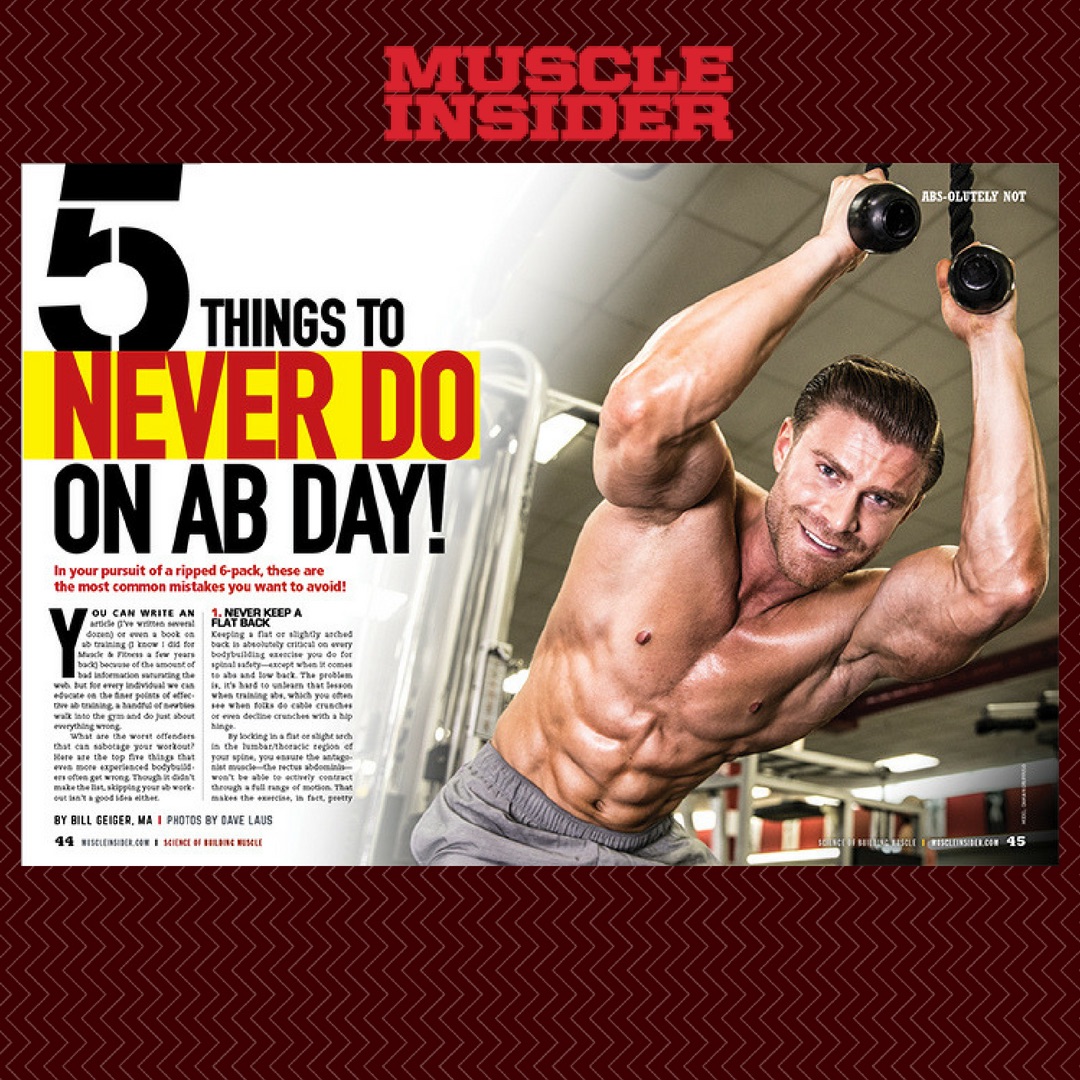
In your pursuit of a ripped 6-pack, these are the most common mistakes you want to avoid!
You can write a book on ab training because of the amount of bad information saturating the web! But for every individual we can educate on the finer points of effective ab training, a handful of newbies walk into the gym and do just about everything wrong. All in an attempt to simply transform their midsection.
What are the worst offenders that can sabotage your workout? Here are the top five things that even more experienced bodybuilders often get wrong. Though it didn’t make the list, skipping your ab workout isn’t a good idea either.
1. NEVER KEEP A FLAT BACK
Keeping a flat or slightly arched back is absolutely critical on every bodybuilding exercise you do for spinal safety—except when it comes to abs and low back. The problem is, it’s hard to unlearn that lesson when training abs, which you often see when folks do cable crunches or even decline crunches with a hip hinge.
By locking in a flat or slight arch in the lumbar/thoracic region of your spine, you ensure the antagonist muscle—the rectus abdominis—won’t be able to actively contract through a full range of motion. That makes the exercise, in fact, pretty useless. When you contract the rectus abdominis, you want to bring the pelvis and rib cage closer to each other, which stretches the low-back musculature (erectors). You can see how an isometric contraction on one side (erectors) of the hip joint hinders the antagonist muscles from being able to stretch and then contract fully. What often happens, then, is that you hinge at the hips rather than achieve significant shortening of the rectus abdominis muscle.
Curl your spine in a controlled manner on the concentric motion of ab exercises while allowing your mid-back to round. If you keep it flat, you won’t be able to effectively work your midsection musculature.
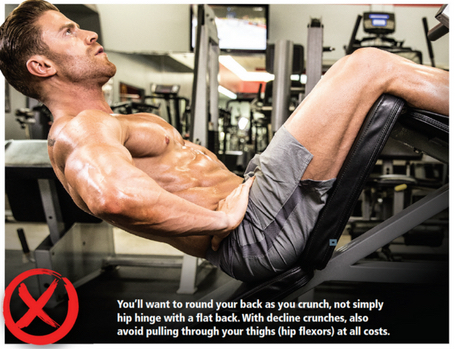
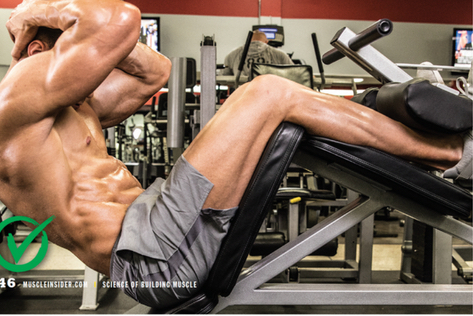
2. NEVER THINK THE ABS ARE AN ALL-OR-NOTHING MUSCLE
There’s significant misinformation too that suggests you can’t emphasize the lower or upper region of the rectus abdominis over the other. That’s nonsense. In most cases, it’s due to a misunderstanding that a muscle fires all or nothing, when in fact a muscle fibre is what fires all or nothing. Tens of thousands of fibres may make up a given muscle. And while you can’t isolate a region of a muscle, you can emphasize one by accounting for angles in your training.
On chest day, you focus on the upper pecs by using incline benches. Similarly with abs, to focus on the upper region most directly, stabilize your lower body so that you bring your rib cage toward your pelvis, as when doing a crunch with your feet on the ground. Here, there’s a greater degree of shortening on the upper end of the rectus abdominis and relatively little on the lower end. Conversely, with a hanging leg raise, your upper body is stabilized while you raise your legs up, which curls your pelvis up and bringing it toward the rib cage. Here, there’s a greater degree of shortening of the rectus abdominis toward the lower end.
Some ab movements allow shortening at both ends, such as a crunch in which your rib cage and pelvis are moving toward each other simultaneously, which effectively targets both ends. Some crunch machines also allow you to do this.
Oblique movements require twisting, rotating, or working in the lateral plane, such as when doing side bends.

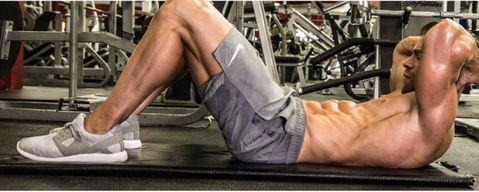
 3. NEVER BE AFRAID OF USING RESISTANCE
3. NEVER BE AFRAID OF USING RESISTANCE
Body-weight ab exercises are great but have one critical limiting factor: You can’t increase the overload by adding weight (load). As you do more reps or reduce between-sets rest time. That’s of limited effectiveness when building strength or size.
That’s one reason to opt for weighted ab movements: As you get stronger, it’s easier to add another plate to the stack to keep making further improvements, a concept we know as progressive overload. Another benefit to resistance movements is that you can choose exercises that allow you to train in lower or moderate rep ranges.
And that brings us to a discussion of muscle-fibre types. While the abs contain a greater percentage of slow-twitch muscle fibres compared to other skeletal muscle groups, that doesn’t mean you want to abandon the moderate-rep approach that best focuses on fast-twitch fibres that are most prone to growth. Many body-weight movements you can do for high reps don’t effectively target the fast-twitch fibres. They do work the endurance (slow-twitch fibres) more effectively, yet those simply become more aerobically efficient rather than growing in size.
If you’re looking to build up the bricks of your three-dimensional six-pack, resistance movements that allow you train in the lower rep ranges will best elicit hypertrophy and should be done early in your workout. Choosing a weight that you can do for sets of 8 to 12 reps to failure is a good place to start, but experiment a bit and see if a slightly higher rep target is more effective. Remember, the deep muscle burn will most likely be felt on higher-rep sets, which should be saved for the end of your training session.
4. NEVER THINK HIP FLEXOR ENGAGEMENT WILL DELIVER RESULTS TO YOUR ABS
You’ve probably heard about the hip flexors and how they can take over an ab movement. The hip flexors are a group of upper thigh muscles that attach below the pelvis, whereas the rectus abdominis attaches above the pelvis. You can work both muscle groups during an “ab” exercise, or just one or the other. Let’s see if we can clear up some confusion to reduce hip-flexor engagement to better focus on just the abs.
Hang from a pull-up bar, keeping your body straight. Now raise your legs up about 60 to 70 degrees. If you look to the side in a mirror, you’ll notice how your glutes haven’t budged much (an indication the pelvis hasn’t moved closer to the rib cage, which is essential in an abs exercise). That’s an indication your lower abs aren’t yet even actively engaged; yep, it’s all hip flexors to this point. Makes sense, as the hip flexors are responsible for raising your legs (hip flexion). If you don’t bring your legs (or knees, in hanging knee raises) any higher than this on your hanging movements, you’re not getting much bang for your buck. Now continue raising your legs well past that point—go as high as you can—and you’ll see how your glutes and lower back start to curl up. (Here, muscle shortening on the lower end of the rectus abdominis is bringing the pelvis toward the rib cage.)
And that’s the critical difference between recruiting the abs over the hip flexors! What’s more, anchoring your lower legs or feet on upper-ab exercises, as when doing decline bench crunches or sit-ups on the floor, makes it all too easy to “pull” through your upper thighs rather than using your abdominals to rise up. If your thighs are burning after a set of decline crunches, that’s a sure sign the hip flexors are doing most of the work.
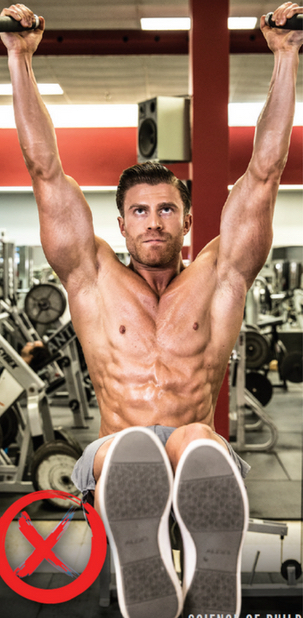

5. NEVER THINK EXERCISE CAN OVERCOME A BAD DIET THAT BLURS YOUR ABDOMINAL DEFINITION
There’s a common perception that if you blow your diet, all you need to do is exercise more to wash it away. But consider that a 500-calorie piece of cheesecake will “cost” you about two hours on the treadmill, a trade few of us would consider reasonable.
What’s worse, any excess calories get stored as body fat, which for men contributes to adding one more belt size along your waistline. Keep that kind of math up and you won’t be seeing your abs anytime soon.
The abs, unlike other skeletal muscle groups, require you to shed a significant amount of body fat to become visible. They may be strong, they may be pronounced, but if they’re under a layer of blubber, your hard-training efforts may be in vain.
If you’ve got a battle with the bulge, straighten out your diet and consider high-intensity interval cardio training to incur a daily caloric deficit. That, combined with a smart ab-training program, will over time begin to produce the visible results you’re seeking.

